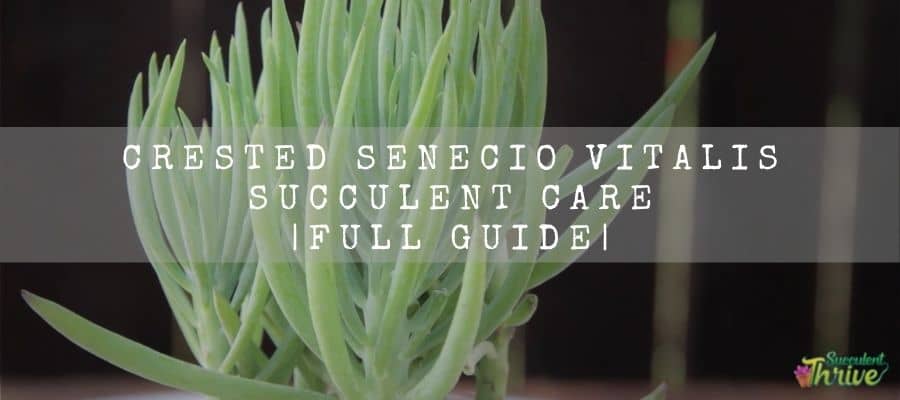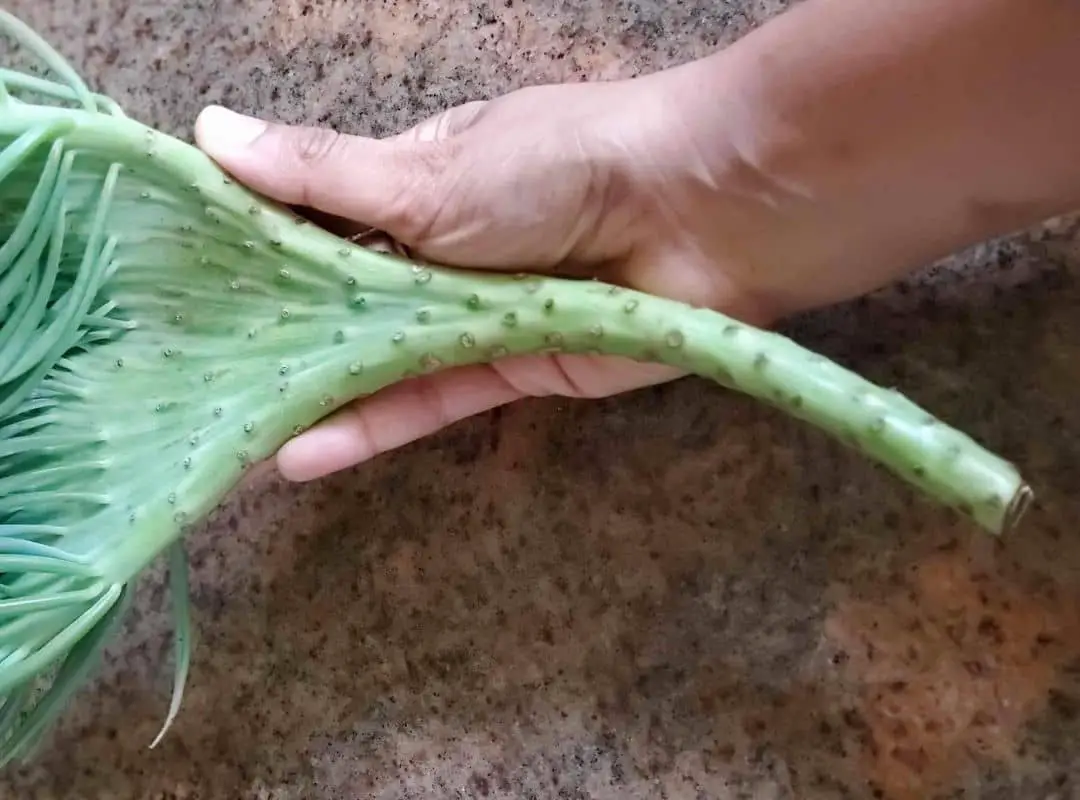When I first saw the Crested Senecio Vitalis, or mermaid tail succulent, I did not believe it was a succulent. I remember the shop owner trying to explain to me that this is a succulent and that it is native to the eastern cape of South Africa. Succulent or not, I liked the plant the first time I saw it. So I bought it, and my research revealed that it is a difficult plant to find.
With low water and maintenance requirements, the plant is super simple to take care of. Not only that, mermaid tails like to grow in well-drained, sandy soil and in soil under the sun or in light shade. It is also highly drought-resistant, which makes it ideal for the forgetful caretaker.

How do I identify a Mermaid tail?
The succulent has a very unusual and unique appearance. The stem of the plant is similar to a fish’s or whale’s fin. These plants will carry big underwater sea vibes into your home, and it would usually be one to two feet tall and can be three to five feet wide, making it look like a mermaid or whale fin.
The plant’s bluish-green color makes it a perfect addition to any room with a neutral color or an ocean theme.
The plant reaches up to 60 cm (2 feet) tall and can grow up to 1.52 m (5 feet) broad. They have a wavey Mermaid Tail that emerges from the fan-shaped base. Mermaid Tail is gray-bluish, but if the plant is “happily stressed” as it matures, leaves will glow green with purple tips.
Mermaid Tail appears to have spiked cactus-like bumps on the base. If you look close enough, around the rising point, you can see the flattened stem. This is what makes the sprouting leaves on the plant short and swollen.
At the bottom and extended out at the top, stems appear fused together, creating the look seen on the crested Senecio Vitalis succulent. The succulent mermaid tail gets the crest from the warped shoots that this method produces.
How do you take care of a Mermaid tail?
Size
The plant reaches up to 45-60 cm (18-24 inches) tall and can grow up to 90-150 cm (3-5 feet) broad.
Growth
It is a fast-spreading plant and grows up to 45-60 cm. Unlike other plants, this plant can grow more broad than high. It is an easy succulent plant to grow.
Light Requirement
In the sun or in light shade, it grows. Direct sunlight is most important for the best growth of the plant during 6-8 hours each day. But, they can be grown outdoors in partial shade.
Temperature and humidity
They can tolerate temperatures as low as 30 degrees of Fahrenheit (-1 degrees of Celsius)
Is it cold hardy?
Crested Senecio Vitalis is not succulent that is cold hardy. If temperatures in your region appear to dip below 30 degrees of Fahrenheit (-1.1 degrees of Celsius), planting this one in a jar that you can carry indoors when appropriate is wise.

Zone
The Hardiness zone is 10a to 11b: from 30 degrees of Fahrenheit (-1.1 degrees of Celsius) to 50 degrees of Fahrenheit (10 degrees of Celsius).
Watering Requirement
This succulent need less or limited watering. Before watering again, let the soil dry well. you can use soak and dry method for watering. Root rot can happen due to overwatering. Sufficient soil enhances importance to the water to flow in. Don’t let the pot rest in a water saucer either. The circumstances depend on how much water is used.
Soil Requirement Type / pH
Crested Senecio Vitalis likes sand or dirt that is well-drained. The mermaid tail plant is a highly drought resistant plant. So. it can tolerate long dry cycles.
They can be tolerated in all pH levels from acidic to alkaline.
Flowering and Fragrance
During early spring and late summer periods, they produce clusters of small/tiny ten to fifteen white color flowers.
Potting and Repotting
Crested Senecio Vitalis growing in a pot is important to have better drainage. Because high moistened soil can be root rot.
Repotting can be done when the soil does not drain well and plant start to die.
Where to Plant
They are growing in sun or light shade prefers well-drained and sandy soil. It is a good idea to plant in pots due to easy maintenance.
you can plant the them in the ground or in a jar/pot during the warmer months, and it can be brought indoors during the winter.
Fertilizer and time of year
Crested Senecio Vitalis does not need much fertilizer. Indoor container plants need half-strength diluted liquid fertilizer 3 or 4 times during the growing stage. But ground varities do not need any fertilizers as feed.
Dormancy
This suggests that the spread of the mermaid tail develops in the winter and it is dormant in the summer, which most succulents do not do.
Other plants Pairs Well With
Crested Senecio Vitalis can be grown in pairs with Kalanchoe, aloe and large agave.
Is Mermaid tail toxic?
The answer to this question is “Yes”. They can be toxic to both pets and humans.
Can be toxic to pets
The answer to this question is “Yes”. Crested Senecio Vitalis can be toxic to pets. So, pet owners should be paying attention to care for their pets from these succulents.
Common bugs and Illness issues
Crested Senecio Vitalis is a disease-free plant like most succulent.
They are particularly vulnerable to fungal infections and root rotting due to overwatering. This problem can be solved by preventing overwatering and can be repotted when the soil does not drain.
However, leaves of the plants can be caused by yellowish color due to Mealybug pests and aphids’ pests. As the treatment for this illness, you can wash and clean the pests by using a soft cloth or cotton swab dipped in rubbing alcohol.
Due to fungal and bacterial rots, leaves of mermaid tail plants can be dropped. Answer to this problem is enough light and watering for both indoor plants and outdoor plants.
Special Care tips
- Do not overcrowd the succulents.
- Do not overwater your succulent
- Annual pruning should be done before the start of the growing season
- Pruning is a good idea to control and maintain the size and spread
- Due to freezing temperatures outdoors mermaid tail plants will be died during one or two days. In these conditions’ plants can be covered with a blanket or burlap or can be brought inside a plant container inside.
- Indoor plants contain too much organic matter and hold much water. So, due to this reason plants suffer from drooping and root rotting that will eventually die. Then you can report if the container does not drain well and leaves start dropping off.
How do you propagate a Mermaid tail?
The Crested Senecio Vitalis readily propagated from cuttings. It is the recommended method for propagation.
- To cut the stems, put on a pair of nitrile-dipped gloves before continuing because the succulent plant can be toxic.
- To cut off the stem from near the base of the mother plant, just use a sterile and sharp knife.
- Stem cutting is placed under the shaded area and allows it to dry and callus for a day or two weeks
- replant it in well-drained, fresh soil. Do not water until fresh cutting readjusts to the new environment.

Mermaid tail plant benefits
- They are important as a bedding plant or border plant.
- Good choice for Mediterranean gardens when paired with aloe,
- agave etc.
- Interesting choice in patio, containers and hanging baskets.
FAQ
Is Mermaid tail an indoor plant?
The answer to this question is “Yes”. This low-maintenance Mermaid tail succulent, except when temperatures get too high, is ideal for growing indoors or outdoors.
Do Mermaid tail need direct sunlight?
In the sun or in light shade, it grows. In direct sunshine, they survive. But do not need direct sunlight.
Credit to : Brittney Adlynne
